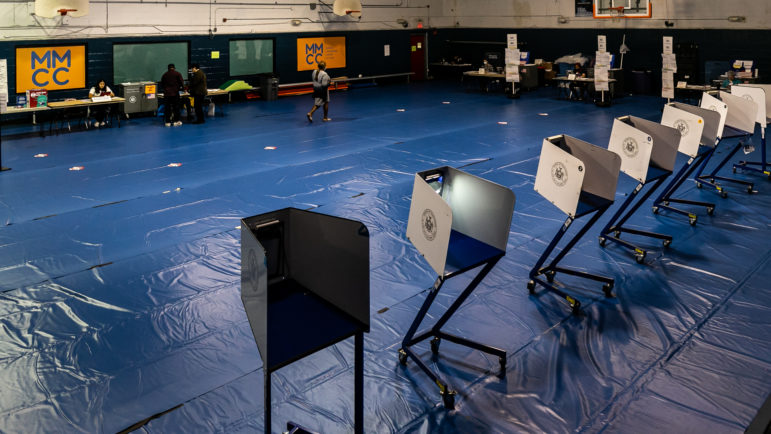The legal battle over redistricting this year resulted in two primaries for New York, including Tuesday’s rare August contests for State Senate and Congress. City Limits spoke to city residents about what they’re looking out for this second summer Election Day—or if they’re looking at all.

Adi Talwar
An empty polling site in The Bronx during the first primary back in June.
It’s Primary Day in New York—again. But not everyone knows about it.
Voters will cast ballots Tuesday in about two dozen races, the second of two primary elections this summer thanks to a bruising legal battle over redistricting earlier this year, in which a court ordered new electoral maps be drawn late in the season and pushed back the primary date for State Senate and Congressional contests.
The odd voting calendar has experts worried about dismal voter turnout. Not every district has a competitive race on the ballot Tuesday, and many voters will find their districts entirely redrawn. Primaries are also unusual for New York in August, a month when schools are closed, community boards are on hiatus and many city residents are out of town or are otherwise checked out of local civic happenings.
“I thought the next election was in November,” Queens resident Patricia Orduna recently told a City Limits reporter in Spanish, saying she voted in the first primary in June, which featured races for governor and State Assembly, but wasn’t aware another was slated for Tuesday.
“August is a pretty bad time just because, number one, it’s completely out of sync with the city, state and federal political calendars at large,” said Michael Lange, a political organizer who writes about local elections. “Voting isn’t really on anyone’s radar in August.”
Fewer New Yorkers voted early this month, too, when compared to June. During the early voting period from Aug. 13-21, some 76,335 residents from both major parties hit the polls, compared to 86,890 who voted early for the primary two months ago, according to the city’s Board of Elections.
And turnout in June on actual primary day wasn’t amazing, either: 474,430 Democrats and 52,308 Republicans voted for governor within the five boroughs then, according to NYCBOE, just a portion of the more than 3.3 million active Democrats and 501,848 Republicans registered in the city as of 2021. By comparison, 941,566 city voters turned up for the gubernatorial primary in September 2018 (New York moved its state primary to June a year later to so that voting for both federal and state contests would take place on the same day—a response to criticism at the time that holding two different primaries each year inevitably suppressed voter turnout).
With just candidates for State Senate and Congress on Tuesday’s ballot, some districts in the city have no contested primary races to vote in at all—including politically active areas like southeast Queens and central Brooklyn, Lange said—another factor making it easier for New Yorkers to tune out the second election of summer.
Other areas with competitive races, though, may see more crowds at the polls. A bevvy of candidates are vying to represent the newly redrawn Congressional District 10, which stretches from lower Manhattan to Brooklyn’s Bay Ridge, arguably the most-watched race this summer. And redistricting has longtime lawmakers Jerry Nadler and Carolyn Maloney competing against one another for Manhattan’s new Congressional District 12.
Those high-profile races and recognizable names will likely boost voter turnout in those specific neighborhoods, Lange predicts. “Once all the votes are tallied, you’re going to definitely have more votes within New York 10 in New York 12 than you did in June,” he said.
That was a factor for Jane Mattes, a Upper East Side and District 12 resident who said she planned to vote on Tuesday and has been following the Nadler-Maloney match up.
“I like Maloney a lot and think it’s sad that the state has combined the Upper East Side and Upper West Side in redistricting so we inevitably lose one of two excellent representatives,” she said, saying she was rooting for Maloney herself. “I feel it’s essential to vote, especially now when we are in danger of losing our democracy.”
Then, of course, there are New Yorkers who don’t have the option of voting Tuesday. New York is one of about two dozen states with closed primaries, meaning only voters registered with a given political party get to vote in that party’s primary election, according to the advocacy organization Open Primaries.
That means Bob Haggerty, a registered Independent, won’t get to cast his ballot this year until the general election in November, when in a left-leaning city like New York, many races will have effectively been decided by the earlier Democratic primary.
But that doesn’t bother Haggerty, a 75-year-old Hell’s Kitchen resident—putting him in Congressional District 12, where he expects Nadler to win, but doesn’t care either way.
“Their politics are identical,” he said of Nadler and rival Maloney.
“I have issues with both parties. I know a Republican will never win,” he added. “I’d like to see a centrist party, but I don’t think that will happen in my lifetime.”








